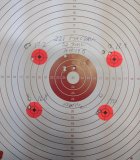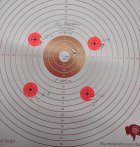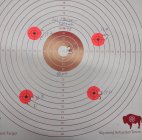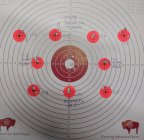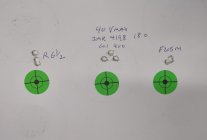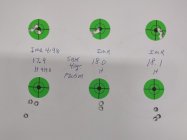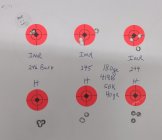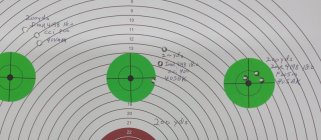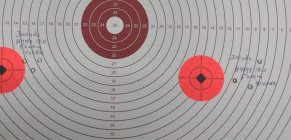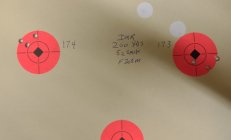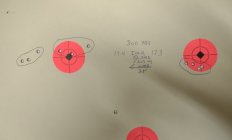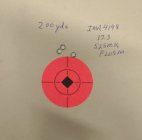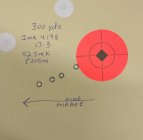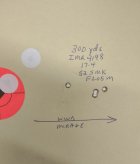lawman29
Gold $$ Contributor
I previously posted a thread on my custom Ruger No 1 221 Fireball build done by Keith Kilby of Wyoming Armory. What follows will be the results of my load development testing.
Rifle Particulars: Brux barrel 1x12.5 twist, 219/224, heavy target, approximately 26". Jard Trigger 1 lb. JGS SAMI reamer.
Optics: During testing I used two scopes: 1) Leupold VXIII 8.5-25x50 LR varmint hunter reticle and 2) Zeiss Conquest V4 6-24x50 with #60 plex reticle. One of the challenges was finding a scope with an uncluttered reticle, 2nd focal plane and a variable range to target shoot and "hunt" (varmints, vermin and other such critters) with an expected range of up to 300 yds (I have a 22/250 and 6br for longer distances). The Leupold had a finer cross hair, but the other stadia lines didn't work for 221 velocities (take off cap and dial), while the Zeiss cross hair was thicker but has an exposed elevation turret; both worked well. However, the old adage "aim small shoot small" left my old eyes hankering for more magnification while target shooting...
One of the great things about todays world is the wealth of information out there as compared to 40+ years ago when I started (ie. our forum...). I have the Berger, Hornady, Nosler and Sierra reloading manuals, Sierra's my favorite, while I consider the Berger useless. However, Ken Waters "Pet Loads" was the first place I went (after talking to Keith who had built a fireball clear back in the late 80's). He wrote a great article back in 1987 about the Fireball. He discusses stuff none of your generic reloading books cover (case expansion, pressure increases/curves etc). His recommendation was H/IMR 4198 with 45 grain bullets (didn't test 40 grain) and H322 for 50+. Oh and he actually tested primers Rem 7.5 vs 6.5, he found the 6.5 to be more accurate in most loads.
Reloading Equipment: Forester Co-ax, Redding S type bushing size die, Redding standard seater with micro seating plug and Fx120i scale.
Components: Lapua brass, 40 Vmax, 40 SBK, 52 Berger and 52 SMK, H/IMR 4198 and Remington, CCI and Federal primers.
I tested at 100, 200 and 300 yards at the Cody Shooting Complex; shooting off a concrete bench with a Hart front rest and rear bag. During the course of testing I shot approximately 300 rounds...one of the draw backs of a fireball is they're too much fun to shoot and you end up doing a lot of 'playing'...(However, the same principles apply to these little cartridges - remember - barrels speed up, things will change). Prior to sending any rounds downrange, Keith had a chat with me about expectations; remember this is a two piece wood stock etc etc etc...it is not your 22 lb Fclass rilfe with 3" wide flat forearm parallel to the barrel as well as the butt stock and a 50x March... Developing proper gun management was a considerable part of the equation.
Results:
Brass: Lapua brass measured 1.395 +/- .001, weight 82.0 - 83.2 variance of 1.2 gr. There was a portion of the brass that were not trimmed until after 6 firings and grew 0.015 - 0.021, they grow you will need to monitor and trim as needed. Primer pockets stayed tight. A loaded round (52 SMK) measured ~ .248. I tested 246, 245 and 244 bushings, 246 was the winner. In addition when I started this project over a year ago I did purchase some Nosler 221 brass, I did not test fire it but did measure it: 1.390 +/- .001, weight 83.3 - 83.7 variance 0.4 gr. (more consistent than the Lapua).
Bullets: During testing of the bullets I ended up selecting the 40 SBK over the 40 VMax. I felt like it was a little bit more consistent, but I can't quantify that for you. The 52 Berger and 52 SMK both shoot well, but I choose the 52 SMK and also picked it over the 40 grainers. I tested several times under less than ideal conditions, wind, mirage etc and I thought the 52s would handle 'hunting' weather better. This isn't quick load data (don't have it), this is just pulling the trigger and looking at what's happening downrange, particularly at 300.
Powder: H/IMR 4198; NO they aren't the same. IMR is bulkier, if your powder measure is set to dump 17.5 grains of H4198 you'll be about a grain less when dumping IMR4198. My accuracy loads were 18.0 H/IMR 4198 for 40s and 17.4/17.3 for 52s. Knowing the inevitable question would be asked what were your numbers, I talked Keith into bringing his Labradar out and shot 3 rounds each for the following 4 loads for a guestimate on velocity.
40 SBK 18.0 IMR4198 = 3,242
40 SBK 18.0 H4198 = 3,119
52 SMK 17.4 IMR4198 = 3,058
52 SMK H4198 = 2,947
Primers: PRIMERS MATTER!!!! I have read on our forum some folks doing testing with 'A' primer or I only have primer 'A' what do you think - with the inevitable answer just try this powder and you'll be okay. Well if okay is good enough so be it or maybe you get lucky and it's the 'one'. Well my experience and many others who have posted find that primers matter (you'll really see it at long distances in comp guns). In particular with lower powder capacity cartridges little things matter and primers are very important. The concept of a 'node' is different, when you're only putting 14 - 20 grains in some of these cartridges a tenth matters...I'm not looking for a node, I will note how it looks a tenth higher and lower to maybe shade one way or the other but that's it. When I started testing after the initial sight-in I did a primer test with Rem 7.5, BR4 and F205M with the 52 SMK and H4198 and charges from 16.8 - 17.5. It was obvious and the 7.5s were kicked to the curb and the F205M was sticking it's chest out. In subsequent testing the F205M was the winner with the CCI 400/BR4 a close second.
How accurate you say...although at times I got .25 or maybe a little less, consistency would be at about 3/8 inch. As I got to 200 and 300 some good ones, but any little changes were reported downrange on the target . At Cody if you're going to shoot you've just got to go for it...
. At Cody if you're going to shoot you've just got to go for it...
I'll reply to this post with a few targets.
Rifle Particulars: Brux barrel 1x12.5 twist, 219/224, heavy target, approximately 26". Jard Trigger 1 lb. JGS SAMI reamer.
Optics: During testing I used two scopes: 1) Leupold VXIII 8.5-25x50 LR varmint hunter reticle and 2) Zeiss Conquest V4 6-24x50 with #60 plex reticle. One of the challenges was finding a scope with an uncluttered reticle, 2nd focal plane and a variable range to target shoot and "hunt" (varmints, vermin and other such critters) with an expected range of up to 300 yds (I have a 22/250 and 6br for longer distances). The Leupold had a finer cross hair, but the other stadia lines didn't work for 221 velocities (take off cap and dial), while the Zeiss cross hair was thicker but has an exposed elevation turret; both worked well. However, the old adage "aim small shoot small" left my old eyes hankering for more magnification while target shooting...
One of the great things about todays world is the wealth of information out there as compared to 40+ years ago when I started (ie. our forum...). I have the Berger, Hornady, Nosler and Sierra reloading manuals, Sierra's my favorite, while I consider the Berger useless. However, Ken Waters "Pet Loads" was the first place I went (after talking to Keith who had built a fireball clear back in the late 80's). He wrote a great article back in 1987 about the Fireball. He discusses stuff none of your generic reloading books cover (case expansion, pressure increases/curves etc). His recommendation was H/IMR 4198 with 45 grain bullets (didn't test 40 grain) and H322 for 50+. Oh and he actually tested primers Rem 7.5 vs 6.5, he found the 6.5 to be more accurate in most loads.
Reloading Equipment: Forester Co-ax, Redding S type bushing size die, Redding standard seater with micro seating plug and Fx120i scale.
Components: Lapua brass, 40 Vmax, 40 SBK, 52 Berger and 52 SMK, H/IMR 4198 and Remington, CCI and Federal primers.
I tested at 100, 200 and 300 yards at the Cody Shooting Complex; shooting off a concrete bench with a Hart front rest and rear bag. During the course of testing I shot approximately 300 rounds...one of the draw backs of a fireball is they're too much fun to shoot and you end up doing a lot of 'playing'...(However, the same principles apply to these little cartridges - remember - barrels speed up, things will change). Prior to sending any rounds downrange, Keith had a chat with me about expectations; remember this is a two piece wood stock etc etc etc...it is not your 22 lb Fclass rilfe with 3" wide flat forearm parallel to the barrel as well as the butt stock and a 50x March... Developing proper gun management was a considerable part of the equation.
Results:
Brass: Lapua brass measured 1.395 +/- .001, weight 82.0 - 83.2 variance of 1.2 gr. There was a portion of the brass that were not trimmed until after 6 firings and grew 0.015 - 0.021, they grow you will need to monitor and trim as needed. Primer pockets stayed tight. A loaded round (52 SMK) measured ~ .248. I tested 246, 245 and 244 bushings, 246 was the winner. In addition when I started this project over a year ago I did purchase some Nosler 221 brass, I did not test fire it but did measure it: 1.390 +/- .001, weight 83.3 - 83.7 variance 0.4 gr. (more consistent than the Lapua).
Bullets: During testing of the bullets I ended up selecting the 40 SBK over the 40 VMax. I felt like it was a little bit more consistent, but I can't quantify that for you. The 52 Berger and 52 SMK both shoot well, but I choose the 52 SMK and also picked it over the 40 grainers. I tested several times under less than ideal conditions, wind, mirage etc and I thought the 52s would handle 'hunting' weather better. This isn't quick load data (don't have it), this is just pulling the trigger and looking at what's happening downrange, particularly at 300.
Powder: H/IMR 4198; NO they aren't the same. IMR is bulkier, if your powder measure is set to dump 17.5 grains of H4198 you'll be about a grain less when dumping IMR4198. My accuracy loads were 18.0 H/IMR 4198 for 40s and 17.4/17.3 for 52s. Knowing the inevitable question would be asked what were your numbers, I talked Keith into bringing his Labradar out and shot 3 rounds each for the following 4 loads for a guestimate on velocity.
40 SBK 18.0 IMR4198 = 3,242
40 SBK 18.0 H4198 = 3,119
52 SMK 17.4 IMR4198 = 3,058
52 SMK H4198 = 2,947
Primers: PRIMERS MATTER!!!! I have read on our forum some folks doing testing with 'A' primer or I only have primer 'A' what do you think - with the inevitable answer just try this powder and you'll be okay. Well if okay is good enough so be it or maybe you get lucky and it's the 'one'. Well my experience and many others who have posted find that primers matter (you'll really see it at long distances in comp guns). In particular with lower powder capacity cartridges little things matter and primers are very important. The concept of a 'node' is different, when you're only putting 14 - 20 grains in some of these cartridges a tenth matters...I'm not looking for a node, I will note how it looks a tenth higher and lower to maybe shade one way or the other but that's it. When I started testing after the initial sight-in I did a primer test with Rem 7.5, BR4 and F205M with the 52 SMK and H4198 and charges from 16.8 - 17.5. It was obvious and the 7.5s were kicked to the curb and the F205M was sticking it's chest out. In subsequent testing the F205M was the winner with the CCI 400/BR4 a close second.
How accurate you say...although at times I got .25 or maybe a little less, consistency would be at about 3/8 inch. As I got to 200 and 300 some good ones, but any little changes were reported downrange on the target
I'll reply to this post with a few targets.










